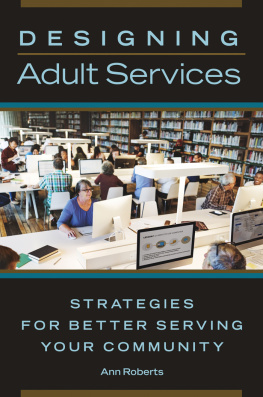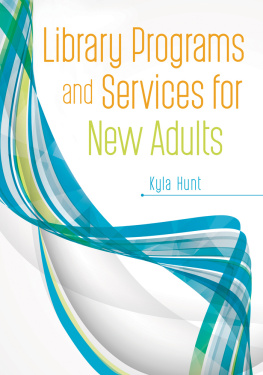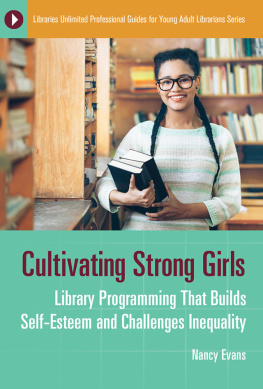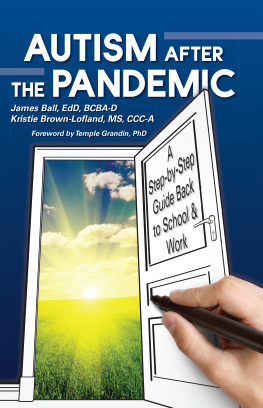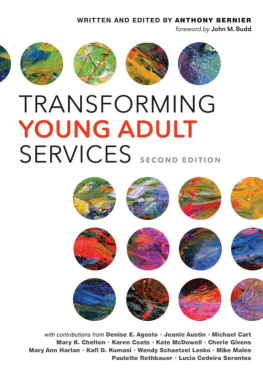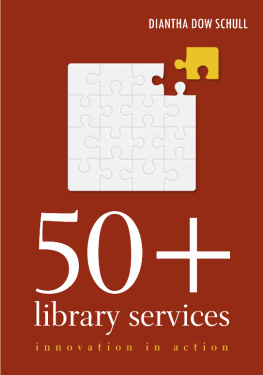DESIGNING ADULT
SERVICES
Strategies for Better Serving
Your Community
ANN ROBERTS

Copyright 2018 by Ann Roberts
All rights reserved. No part of this publication may be reproduced, stored in a retrieval system, or transmitted, in any form or by any means, electronic, mechanical, photocopying, recording, or otherwise, except for the inclusion of brief quotations in a review, without prior permission in writing from the publisher.
Library of Congress Cataloging-in-Publication Data
Names: Roberts, Ann, 1958 author.
Title: Designing adult services : strategies for better serving your community / Ann Roberts.
Description: Santa Barbara, California : Libraries Unlimited, an imprint of ABC-CLIO, LLC, [2018] | Includes bibliographical references and index.
Identifiers: LCCN 2017031516 (print) | LCCN 2017049116 (ebook) | ISBN 9781440852558 (ebook) | ISBN 9781440852541 (paperback : acid-free paper)
Subjects: LCSH: Adult services in public librariesUnited States. | Libraries and older peopleUnited States. | Adult services librariansUnited States. | Libraries and communityUnited States.
Classification: LCC Z711.92.A32 (ebook) | LCC Z711.92.A32 R63 2018 (print) | DDC 027.62/20973dc23
LC record available at https://lccn.loc.gov/2017031516
ISBN: 9781440852541 (paperback)
9781440852558 (ebook)
22 21 20 19 181 2 3 4 5
This book is also available as an eBook.
Libraries Unlimited
An Imprint of ABC-CLIO, LLC
ABC-CLIO, LLC
130 Cremona Drive, P.O. Box 1911
Santa Barbara, California 93116-1911
www.abc-clio.com
This book is printed on acid-free paper 
Manufactured in the United States of America
Contents
Acknowledgments
I would like to thank the following individuals, libraries, and library and educational agencies for input and contributions to this work:
Kim Flores, Naphtali Faris, and Michael Anderson, Mid-Continent Public Library, Missouri
Penny Peck, California
Steve Carr, Arlington Public Library, Virginia
Michele Cordero, U. S. Patent and Trademark Office, Virginia
John Paul Myrick, Cross County Library, Arkansas
Linda Hofschire, Colorado State Library, Colorado
John Taube, Allegany County Library, Maryland
Cyndi Lessner, Maryland State Department of Education, Early Childhood Development, Maryland
Jennie Garner, North Liberty Community Library, Iowa
Laurie Orton, San Juan Island Library, Washington
WebJunction, Washington
Urban Libraries Council, District of Columbia
I would also like to thank my dear friend and editor, Blanche Woolls, and my loving husband, Richard Smith, for their encouragement and assistance throughout my library career, and in this and previous publications.
Introduction
ADULT LIBRARY USERS: THEY CAN BE A TOUGH CROWD
If we live long enough, we are adults for much of our lifespan. Childhood and youth go by in a flash, and while they are probably the most important stages in our development and are certainly worthy of all the focus libraries typically give them, they are not the only stages in our development in life. We continue to grow and learn and have different informational needs in all stages of life. According to the Center for Disease Control, the average life expectancy in the United States is 78.8 years (http://www.cdc.gov/nchs/fastats/life-expectancy.htm), and if we consider that in most states in the United States, adulthood begins at age 18, there is a good 60 years in which libraries can and should be serving adults of all ages. And during that 60-year time span, we continue to change and grow almost as much as we did in our youth, if not physically, then certainly intellectually, spiritually, and emotionally. Frequently, changes in life are brought about by lifes situations, situations in which we have to learn and adapt to new jobs, new surroundings, new people, new illnesses, having childrenthe list can go on and on. I have chosen to use a generational approach in this book for following reasons:
- It makes good sense.
- It makes the job of serving adults in libraries a little easier, breaking ideas for services and programs down into more manageable increments.
- It triggers fresh ideas and approaches to providing programs and services.
The stages in life that I have used in this book are loosely based on psychologist Daniel Levinsons theory of adult development (http://study.com/academy/lesson/theories-of-adult-development-levinson-vaillant-neugarten.html). While I understand that many, many peoples lives will not fall neatly into the lifes experiences and stages outlined either by Dr. Levinson in his research or myself in this book, I have based my ideas of library services to adults on what is often happening in the life stages of the majority, beginning with the current youngest generation of adultsthe millennials and ending with library services to seniors, the baby boomers. I will address library services to special populations in an additional chapter, but I also count upon the reader to take the suggestions offered in this book and run with them. Programming ideas for one demographic can easily be tweaked for another. By thinking about what is happening in lifes stages, as well as researching local demographics, planning programming and services seems a little less intimidating. Thinking about what each generation has most in common provides a place to begin.
Since the Young Adult Library Services Association (YALSA) of the American Library Association defines young adults as ages 1218, this book will focus on those adults ages 19 and much older. There is a great deal of living and learning to be done after the age of 18, but it is around that time that libraries often lose touch with users who had been faithful attendants of story hour as children and avid fans of library programs as teens. Sometimes it just seems like adults in libraries are a tough crowd.
But why should that be? you might wonder.
Because adults are usually very busy people, they have less time for library visits or sometimes even for reading. They are studying, taking classes, working, caring for children, helping out older parents, taking care of homes, planning and nurturing careers and investments and retirement funds, and gasp! There are simply not enough hours in a day for all of these activities.
So, how can libraries serve this crazy busy portion of the population? you might ask.
By making their lives better, and maybe even just a little easier, would be the correct response.
And why the generational approach? you might be wondering. If you have lived long enough, you will easily recognize that as we age, we become very different people along the way. I can assure you, I am nothing like I was in my 20s, much to the relief of many people who were genuinely concerned about my well-being. And it does happen almost by decade. Things just change. Our bodies change, our minds change, our lifes circumstances change, and we have different information needs.
Libraries can serve adults of all ages in many ways, by offering convenience in access to good information, technology, lifelong learning, and an intellectually stimulating outing for children, their parents, and grandparents. There is something to be found for every age group at the library. I have, by no means, come up with an exhaustive list of programs and services for each age group but rather hope to inspire the library community to take a generational approach to library service when planning for programs and services. Tailoring library programs to varying age groups not only better serves the public but also makes the job of the librarian easier, once we recognize those varying information needs at various stages in life. Programs and suggested ideas for collection development in each chapter can obviously be used for other age groups, but I offer them as suggestions for specific age groups, according to lifes stages. Each chapter in the book will offer simple programming ideas, with more detailed programs described at the end of Chapters 29, or those chapters devoted to serving specific demographics.

